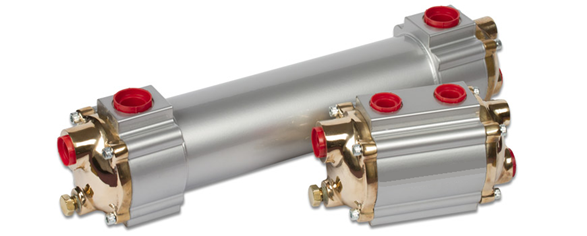Introduction
Marine oil coolers is a specialized heat exchanger designed to remove excess heat from lubricating oil, transmission oil, or hydraulic oil in marine applications. In ships, engines and equipment run for long periods, generating high temperatures. The oil cooler ensures that oil maintains its optimal viscosity and lubrication properties by regulating temperature. It plays a critical role in protecting engine components, reducing wear and tear, and improving overall efficiency.
Working Principle
The oil cooler operates based on the heat transfer process between two fluids:
- Hot oil, which absorbs heat from engine or machinery components, is directed into the cooler.
- Cooling water, usually sea water or fresh water, flows in separate channels or tubes.
- Heat is transferred from the oil to the water through metallic walls, typically tubes.
- The cooled oil is then pumped back into the system for reuse, while the heated water is discharged or recirculated.
The oil and water never mix—only heat is exchanged.
Construction and Materials
Marine oil coolers are constructed to withstand harsh marine environments, including saltwater corrosion and vibration.
Components in Detail:
- Tubes: Thin pipes made of materials like copper-nickel, titanium, or stainless steel which carry the cooling water. These materials are selected for their thermal conductivity and corrosion resistance.
- Shell: The outer body where hot oil flows around the tubes. Usually made from brass, carbon steel, or marine-grade stainless steel.
- Tube Sheets: Flat plates that hold the ends of the tubes in place and ensure a leak-proof seal.
- Baffles: Internal plates that direct the flow of oil across the tubes to enhance heat transfer.
- End Covers: Removable caps at both ends for cleaning and inspection access.
Types of Marine Oil Coolers
Shell and Tube Type
- Most widely used.
- Cooling water circulates inside the tubes while hot oil flows over them in the shell.
- Handles high oil flow rates and pressures.
- Easy to disassemble for cleaning and inspection.
Tube-in-Tube (Double Pipe)
- A compact design where one tube carries oil and the outer concentric tube carries water (or vice versa).
- Ideal for space-constrained installations.
- Fewer parts, easier maintenance.
Plate Type
- Made of multiple thin metal plates stacked together.
- Oil and water flow in alternate layers.
- Offers high thermal efficiency in compact size.
- More suitable for clean water applications, as dirty water may clog narrow flow paths.
Applications of Marine Oil Coolers
- Main and auxiliary marine diesel engine lubrication cooling.
- Gearbox cooling on ships, especially in propulsion systems.
- Hydraulic oil cooling in winches, cranes, and steering gear systems.
- Cooling of stern tube oil, which lubricates the propeller shaft.
- Used in tugboats, cargo ships, navy vessels, trawlers, and offshore platforms.
- Essential for continuous-duty marine operations in both coastal and deep-sea vessels.
Limitations
- Prone to fouling: Marine organisms, scale, and debris may build up, especially in seawater-cooled systems.
- Risk of corrosion: If incorrect materials are used or maintenance is poor, saltwater can degrade components.
- Plate type units clog easily: Not suitable for dirty or untreated seawater.
- Vibration-sensitive: Improper mounting or continuous vibration may cause tube leaks or fatigue.
Maintenance Tips
- Rinse with fresh water after each voyage to remove salt deposits.
- Inspect tubes regularly for signs of corrosion, pitting, or marine growth.
- Use sacrificial anodes to protect metal parts from galvanic corrosion.
- Check seals and gaskets for hardening or wear.
- Monitor inlet/outlet temperatures to detect performance drops indicating fouling.
Selection Criteria
Before choosing a marine oil cooler, consider:
- Engine Size & Oil Flow Rate: Larger engines require higher cooling capacity.
- Oil Type: Lubricating oil, transmission oil, or hydraulic oil each has different properties.
- Cooling Medium: Determine if the ship uses seawater, freshwater, or a closed-loop system.
- Material Compatibility: Choose corrosion-resistant materials based on water type.
- Space Availability: Choose compact designs for restricted areas.
- Heat Transfer Efficiency: Ensure required oil outlet temperatures are met.
- Ease of Maintenance: Consider accessibility and service intervals for long-term operation.
Conclusion
Marine oil coolers are essential components in maintaining the efficiency, safety, and longevity of marine engines and onboard systems. By effectively removing excess heat from lubricating, hydraulic, and transmission oils, they help ensure consistent performance and protect machinery from overheating and premature wear. With various types—such as shell and tube, tube-in-tube, and plate-type—available to suit different vessel sizes and cooling requirements, marine oil coolers are adaptable to a wide range of marine applications. Proper selection based on material, capacity, and environmental conditions, along with regular maintenance, ensures optimal performance even in the harshest sea environments. Investing in a reliable marine oil cooler is a crucial step toward enhancing marine system durability and reducing costly downtime.

